Aqua Safari and Living Underwater, CozumelContents of this Issue: Aqua Safari and Living Underwater, Cozumel Your Fellow Divers Need Your Travel Reports Dehydration and Diving: Facts and Myths Could This Diver’s Death Have Been Prevented? Little Cayman, Cocos, Palau, PNG . . . “They Confirmed He was Dead, Then Left . . . Without the Body” Brutal Murder of Stuart Cove’s Dock Manager Starving Underwater Photographers: Part I Skip the Caribbean: Dive Your Nearest Golf Course A Bad Night on the Wind Dancer Don’t Sign This Lionfish Petition Editorial Office: Ben Davison Publisher and Editor Undercurrent 3020 Bridgeway, Suite 102 Sausalito, CA 94965 Two different dive operators, two different views from the June, 2015 issue of Undercurrent
These days, I get many reader queries about two dive destinations in particular -- Raja Ampat and Cozumel. While we periodically cover Raja Ampat, it has been a while since we've written about Cozumel, and because two of our long-time correspondents were heading there just weeks apart, I decided to run stories with contrasting views about two different dive operators. I think this can be extremely helpful for divers who have never visited Cozumel, and for those who have, perhaps our writers will offer you new options. Now, go get wet! -- Ben Davison * * * * * listening for splendid toadfish Dear Fellow Diver:
While I've made 15 trips to Cozumel, this was the first in three years, and the reef was as vibrant and healthy as it was before devastating Hurricane Wilma in 2005. (Full disclosure: I've made more than 200 paid dives with Aqua Safari, but I can provide an honest evaluation; there are a few warts.) Although the day temperature was in the low 80s, the skies were partly cloudy, but still the colors of sponges and corals were impressive, as were Cozumel's colorful tropical fish. I saw several half-inch juvenile spotted drums as well as huge spiny lobsters. Midnight, queen and rainbow parrotfish scraped algae along the reef, while occasional barracudas sauntered by. One seven-foot nurse shark at Columbia Bricks swam loops around us divers for 10 minutes. At Palancar Caves, among large barrel sponges, I glided through swim-throughs and weaved in, out and around "rooms" surrounded by the towering coral reef. A pair of eagle rays swept by the wall. On most dives, turtles finned along, stopping to munch on sponges while photographers clicked away. Three years ago, I saw lionfish everywhere, but on this trip I saw just two, perhaps a testament to Cozumel dive operators' concerted efforts to eradicate them and to the many restaurants that bake, sauté and fry them. However, I also saw far fewer large groupers than I had on past trips. While as many as a dozen dive boats might be spread around Columbia and Palancar reefs, rarely did I see other divers. When I did, they were usually grouped behind their leaders, in contrast to our divers, who were in singles and pairs, making their own choices. Once, idiots from another group picked up a conch and tossed it back and forth. Mariano forcefully finned over and signaled them to stop, which they sheepishly did. Their divemaster had never looked back. The 35-foot Ocean I holds 12 divers and is said to be the first custom-made dive boat on the island; a lot of loving care has kept it going. It's lined with benches, where tanks are set up. On the top deck, there's both shade and a flat surface for sunbathers. There are no railings above, so when it rains, it's so slippery that an unwary passenger could find himself in the drink. The marine head is small and rusty, but clean. The boat's a workhorse, but a slow horse, lumbering along as other boats pass, taking a good hour to get to most sites. That meant leaving Aqua Safari's in-town dock at 8:15 a.m. and returning around 2 p.m. or later made it impossible for me to grab lunch and take the 2:30 afternoon dives.
Gustavo, Aqua Safari's new manager of dive operations, joined us for two days of diving. Ever the keen eye, he found about a dozen two-inch pipehorses camouflaged in clumps of drifting algae. Gustavo is easy to talk with, on the quiet side, and ever the observer in and out of the water. One day, Mariano sent an inexperienced diver who quickly burned air to the surface alone by Mariano for pick¬up. Mariano sent up his safety sausage while keeping an eye on him until the boat picked him up. While there was little current, I was still concerned because I know of divers who disappeared in Cozumel because of this practice. Another day, we were joined by Gabriel, an instructor, and a Russian woman he had certified the day before. I learned later that when she saw my fins disappearing into a hole, Gabriel had to stop her from making a dash to pull me out and save me. She didn't know divers did that! In 81-degree water, my depth ranged from 86 feet (Columbia Bricks and Palancar Caves) to 33 feet on Paso el Cedral. Since there was just slight current, we either drifted slowly or slightly finned along the reef. I've dived every month in Cozumel, and have found milder currents in February and March, stronger ones from October through December. I love the strong currents when I have to hide behind a reef to explore, or simply "fly" with the current. Most fun for me is when they are changeable, but that's when folks can become separated from their groups. I've helped a couple divers, nearly out of air, who couldn't find their group. Aqua Safari's boats leave from the dock across from the dive shop. They make a stop at the Palace and, on request, may drop off a diver elsewhere on the way home. Aqua Safari is definitely not valet diving, but I chose it because it's the way Cozumel once was, and I'm comfortable there. Divers haul their own gear to the boat, set it up, and rinse and hang it up at the dive shop at the end, though they'll lend a hand if you need it (or even look like you need it). The dive shop could use better ventilation and the floor is slippery, but, well, that's old Cozumel. (Gear storage and drying at Aqua Safari's Palace Hotel-based dive shop are inadequate, I've been told, so divers take their wetsuits back to their rooms' balconies to dry.) I joined nine other divers and divemaster Walter for a night dive at Paradise Reef. It can get crowded there with divers from other boats, but fortunately, we were the only group. I heard that intense varying foghorn "singing," and found a splendid toadfish out of his hiding spot -- most likely a male eager for companionship. Several snake-like sharptail eels slunk along, and spotted morays were out hunting. We all grouped at the end of the dive, watching the iridescent blue- and green-changing colors of an octopus as it climbed over the reef, searching crevices. While I usually stay in a room over the Aqua Safari dive shop or at the Barracuda Hotel, this time I hunkered down at the modern Casa Mexicana on the main street, Avenida Rafael Melgar Sur. My room with small balcony overlooking the city was very clean, with a comfortable queen bed, small fridge and a safe. The bathroom's updated fixtures gleamed and the strong shower had plenty of hot water. A complimentary buffet breakfast, with waffles, made-to-order omelets and lots of fresh fruit topped it off. For other meals, I liked foraging the fine local Yucatan establishments off the main streets, such as Las Flamitas on Avenida 25 (queso relleno), Conchita del Caribe on 65 Avenida Sur (ceviche and fried fish), and around the corner from Aqua Safari, Casta Brava (sopa de lima for lunch), and US$1 beers from a barrel on the sidewalk. Three-course dinners, off the main drag, can be found from $3 to $10, with chelada con sol (beer with lime juice) for a couple bucks. In celebration of my dive buddy's fiftieth year of diving, we went to Guido's, on Avenida Melgar Sur, for their fantastic wood oven-baked garlic pita bread plus entrees. With wine and a margarita, the bill was $100. Cruise ship refugees still clog the main street, and some ruin the ambiance with drunken rude behavior. But when the ships' whistles sounded and they headed back, I could almost hear the sigh of relief as shop owners took a late siesta. (The entire plaza is blocked off, undergoing major upgrading.) I should note that after nearly 50 years in the Cozumel dive business with Aqua Safari, Bill Horn sold his dive operation to the Cozumel Palace a while back. (He still maintains his shop and its accommodations as well as "Condumels" north of town.) I heard complaints from divers about problems resulting from the transition -- delayed boat departures, difficulty making reservations, inadequate drying space, bad lockers at the Palace, etc. -- but Gustavo Vazquez, a well-respected island conservationist and long-time Aqua Safari divemaster, became manager this spring. Happily, many of the divemasters are still with Aqua Safari, as are instructors such as Gabriel. I'm already looking forward to another trip, but longer next time. Prior to the sale to the Palace, Aqua Safari had a fast-boat, owned by its previous manager, Donna, that left at 8 a.m., but Donna provides her own dive trips with it now. -- J.D. Our undercover diver's bio: J. Diver, our undercover reviewer, says, "I began diving 12 years ago, quickly becoming obsessed observing fish and critter behavior. A thousand dives later, with plenty of time to burn, I've made half my dives in the Caribbean and the remainder mostly in Indonesia, Philippines, Japan, Palau, Papua New Guinea, the Solomon Islands and Turkey. Using the excuse of absorbing local culture, I've drunk kava in Fiji, penis soup in PNG, tiger penis sake in Yonaguni, Japan, and enjoyed betelnut chewing and spitting in Palau. I'm convinced it helped my fish ID skills in those regions. I'm too absorbed watching fishes to fiddle with a camera."
* * * * * attention for newbies, freedom for us Dear Fellow Diver: Huge, barnacled, and gray, a leatherback turtle, an avatar of Earth's reptilian past, swam in from the blue. As it came within six feet of me, I could see the saucer-sized scales on its head and almost feel its gaze as it moved on through the canyons at Horse Shoe. My buddy and I were with Jeremy Anschel of Living Underwater, part of a group of seven divers on the first of two morning dives. The turtle was our only big encounter, though an unusual one, that week in early April. On previous trips, I had seen nurse sharks, a pod of dolphins and lots of eagle rays at Eagle Ray Wall, but the bigger animals were not here this trip. However, Jeremy, who excels at finding macro life, discovered a camouflaged pygmy pipehorse on the top of Santa Rosa Wall and a swimming pygmy seahorse at Tormento. For divers of a certain age, a magnifying glass is essential to see the critters clearly.
Next day, the sky was clear and the water in front of my hotel, the Intercontinental Presidente, was flat. Jeremy picked up my buddy and me at 8:30 a.m. We boarded his covered panga, the Jew Fish, and found our gear already set up on steel 120-cubic-foot tanks with Nitrox 32. The nitrox is analyzed at the filling station, but since I wanted to check my own mix, Jeremy brought an analyzer. The twin Yamaha 150s zipped us past boats that had departed earlier, and soon we passed the popular (read "crowded") sites. The farther south we went, the bumpier the ride. Ricardo drove the boat and Pato, so called "because he walks like a duck," handled the gear, snacks and other needs. By the way, I should note that the boat's name is Jeremy's own joke, as one of my fellow writers reported three years ago. When he told Jeremy, who is Jewish, that it had been more than a decade since scientists renamed the jewfish "the Goliath grouper," Jeremy replied, "Not in Cozumel."
After Jeremy jumped in to check the current -- it was indeed flowing north -- Ricardo gave us a 1-2-3 count and we all backrolled into the chop. My buddy and I kicked down to 90 feet as fast as our ears would allow. Looking up, I saw the other team sinking too slowly and because we were expected to be diving as a group, the current pushed us past the Arches' entry point. So we spent the rest of the dive on the slope above the wall where the features were unremarkable and the critters generally ho-hum. Because it was the Canadians' last day, they had asked for a wreck dive. So after a two hour surface-interval at the scruffy Palancar Beach Club, sitting under the thatched palapas, shopping for T-shirts and trying to feed a curious coati, we headed back out, this time dropping down on the C-53 wreck, a decommissioned mine sweeper sitting upright on a sand bottom in 82 feet. It's been set up for limited penetration, with holes cut in the hull and lines attached here and there. In the cramped passageways and compartments leading to the engine room, a line of divers is sure to stir up rust. Glassy sweepers filled one of the compartments, a huge clinging crab hid beneath a metal box and a few grunts hung out. However, the fun is in navigating the tight compartments. As we ended the diving hanging from a line, I watched as the Atlantis submarine motored by in the distance, while a school of horse-eye jacks watched me. I didn't like getting back to the hotel at 2 p.m. from two dives, so I asked if we could shorten the surface intervals, and for the next two days, Jeremy obliged. When you only have one boat, you need to take business as it comes, which means experienced divers may not always be with others, though Jeremy does well accommodating those of us who can handle ourselves -- which is why I return to dive with him. Next day, we picked up two folks who had ferried from Playa del Carmen just for the day. They had a made few dives in the British Virgin Islands and rented all their gear from Jeremy. He announced we were going to Palancar Gardens, and I assured the other couple it was a nice dive, they would be fine and they would have no trouble getting down, especially with the 16 pounds of lead they were wearing. For the 81-degree water, I was wearing a 3-mil vest under a full-length 3-mil wetsuit; with steel tanks, I only needed six pounds of lead.
We dropped to the sandy fore-reef, while Jeremy patiently worked the divers through mask and buoyancy problems. Paddling around the top of the wall, I checked out azure sponges and a few lobsters. I saw Jeremy trying to get the husband to stop flailing his arms about and floating up, so my buddy and I paddled some more. I saw Jeremy demonstrating his meditative pose, prone on the sand breathing slowly, but the two divers were anything but Zen-like. So we paddled some more. At 18 minutes, we gave up paddling, waved goodbye, headed down and finned through a descending tunnel covered in orange rope sponges, and emerged on a spectacular wall of cuts, buttresses and overhangs. At 92 feet, I cruised past enormous barrel sponges and poked my light into crevices, finding lobsters, queen angels, schools of mahogany snappers and blue striped grunts. I watched for the bubbles on top of the reef to keep Jeremy more or less within view in the 100-foot-plus visibility. When I rejoined them, the newbies had burned their air. Jeremy put up his safety sausage, led them to the boat, watched them ascend and then the three of us continued for another 15 minutes. We saw fewer lionfish than on our previous trips, maybe due to the collection tournaments held every year. Jeremy uses an aquarium net to trap them, then crushes their skulls between thumb and forefinger. When I asked him if he ever got stung, he said, "Oh yeah, all the time." The Intercontinental Presidente is pricey and probably worth it, but only just. This was our third spring-break trip in three years, and after previously complaining about the uneven service (it takes endless phone calls to get anything delivered), we received a discount on our beachfront room. While it was a busy Easter week (sometimes after returning from a dive, the room was still not cleaned), the beach, the view and the friendly restaurant staff made up for minor problems. Because the El Presidente is not all-inclusive with booze, the rowdyism found at other hotels is absent. We enjoyed lunches at one of the couches in the open-air restaurant, gazing at the sea. By dinnertime, the kiddie action at the main pool was over, quiet reigned and the happy hour drinks were two-fers with complimentary chips or nuts. We ate at their steakhouse, the Napa Grill. My partner's New York strip was perfectly cooked, and the Béarnaise sauce on my filet was excellent. Pair that with dessert, a bottle of Washington State pinot noir and tip, and we were out about $200. The rest of the time, we took the $9 cab ride into town, where we ate well at Kondesa with its Mex-fusion grub (lionfish appetizers), bespoke cocktails and brilliant service. At Casa Denis, just off the plaza, we had excellent seafood and fajitas while being entertained by fire jugglers and other street acts. At the Bahia del Caribe, at the fishermen's cooperative on Avenida 5, we had several lionfish courses, where there was no problem with lionfish supply. At lunch, Cha Cha's Kitchen serves only a soup and two dishes -- that's it. We had Korean barbecue tacos and a vegan version of the same dish. In addition, a new restaurant called The Restaurant Dracula -- weird for Cozumel, or anywhere, for that matter -- offered Romanian-Mexican fusion lunches. We didn't ask what was on the menu after sunset. -- D.L. Our undercover diver's bio: D.L. got his openwater certification in New York in 1987, having failed a resort course in Jamaica due to a misunderstanding about the local flora. He added C-cards in advanced openwater, rescue, oxygen management, EANx and Advanced EANx, while traveling to the Caribbean, Mexico, Egypt, Hawaii, Papua New Guinea, Australia, Bikini Atoll and Fiji, where he had his appendix out after a memorable 12-hour trip from Taveuni to Nadi on New Year's Day 1988. He has dived the 200- foot-deep Windjammer wreck in Bonaire on air six times, earning him the nickname "Old Twitchy."
|

I want to get all the stories! Tell me how I can become an Undercurrent Online Member and get online access to all the articles of Undercurrent as well as thousands of first hand reports on dive operations world-wide
| Home | Online Members Area | My Account |
Login
|
Join
|
| Travel Index |
Dive Resort & Liveaboard Reviews
|
Featured Reports
|
Recent
Issues
|
Back Issues
|
|
Dive Gear
Index
|
Health/Safety Index
|
Environment & Misc.
Index
|
Seasonal Planner
|
Blogs
|
Free Articles
|
Book Picks
|
News
|
|
Special Offers
|
RSS
|
FAQ
|
About Us
|
Contact Us
|
Links
|
3020 Bridgeway, Ste 102, Sausalito, Ca 94965
All rights reserved.

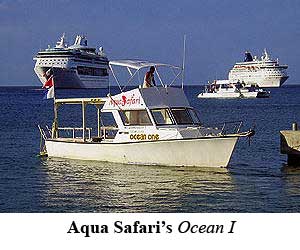 One of my favorite fish is Cozumel's endemic splendid
toadfish, which I look for under low-ceiling recesses
on the sand. The vibrant yellow fin borders and gray-,
blue- and white-striped body pop out, making its discovery
a real treat. As a repeat diver with Aqua Safari, I was
fortunate on this trip to be guided by Mariano, a Yucatan
native who has been
with Aqua Safari
for 20 years. When
I asked if he could
find me a toadfish,
he simply replied,
"How many?"
One of my favorite fish is Cozumel's endemic splendid
toadfish, which I look for under low-ceiling recesses
on the sand. The vibrant yellow fin borders and gray-,
blue- and white-striped body pop out, making its discovery
a real treat. As a repeat diver with Aqua Safari, I was
fortunate on this trip to be guided by Mariano, a Yucatan
native who has been
with Aqua Safari
for 20 years. When
I asked if he could
find me a toadfish,
he simply replied,
"How many?"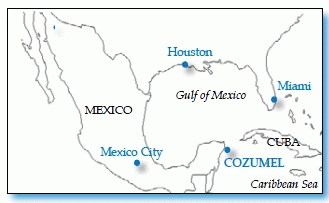 On past trips,
I've been lucky to
see just one, but
this March, I saw
more than 20. I
asked Mariano how
he finds them. "I listen," he said. So at the dive site
named Dahlia, when he pointed out two
along a shallow reef overhang, I, too,
listened. Sure enough, I heard croaking,
foghorn-like sounds. Then, skimming
along the sand, I found eight more
splendid toadfish on my own.
On past trips,
I've been lucky to
see just one, but
this March, I saw
more than 20. I
asked Mariano how
he finds them. "I listen," he said. So at the dive site
named Dahlia, when he pointed out two
along a shallow reef overhang, I, too,
listened. Sure enough, I heard croaking,
foghorn-like sounds. Then, skimming
along the sand, I found eight more
splendid toadfish on my own.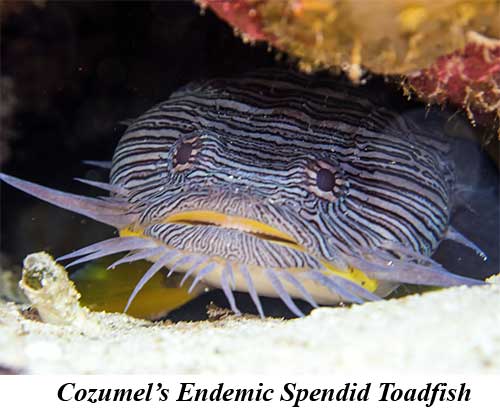 Ivan, the boatman, ensured that everyone's
air was on, handed out cameras
(the water bucket was too small to hold
many cameras), and helped divers wherever
needed. While some divers leapt from
the sides, I, after an awkward step over
a thin half-foot bulkhead, made a giant
stride off the dive platform. Afterwards,
Captain Jorge Chale, who kept close track
of his divers, carefully backed the boat
into position for our pickup. A pull along
a floating trail line got us to the metal
ladder, an easy climb. I'd pass up my
gear and climb aboard, then partake of the fresh fruit as we motored to a calm area for our surface interval. Aqua Safari
has two other boats, both 38 feet and holding 16 divers; divers are assigned
to a boat. They ran all three daily, which was in marked contrast to recent
years when few divers came to Cozumel due to the downward economy.
Ivan, the boatman, ensured that everyone's
air was on, handed out cameras
(the water bucket was too small to hold
many cameras), and helped divers wherever
needed. While some divers leapt from
the sides, I, after an awkward step over
a thin half-foot bulkhead, made a giant
stride off the dive platform. Afterwards,
Captain Jorge Chale, who kept close track
of his divers, carefully backed the boat
into position for our pickup. A pull along
a floating trail line got us to the metal
ladder, an easy climb. I'd pass up my
gear and climb aboard, then partake of the fresh fruit as we motored to a calm area for our surface interval. Aqua Safari
has two other boats, both 38 feet and holding 16 divers; divers are assigned
to a boat. They ran all three daily, which was in marked contrast to recent
years when few divers came to Cozumel due to the downward economy. Divers Compass: My dive package for three days' diving with Aqua
Safari and five nights at Casa Mexicana cost me $695; I paid
for two more dives ($79) and a night dive ($37) . . . I had to
overnight in Houston because of a too-tight flight connection
of just 30 minutes -- first time that's happened in going to
Cozumel . . . I walked the back streets alone at night, depending
upon my dining choices, and never had a worry; locals tell
me they're harassed much more than tourists . . . Since banks
are only open when I am diving, I exchanged $100 at the airport
and used US currency, which is accepted everywhere, the rest of the time . . .
There is plenty for non-divers to do: snorkeling the Chankanaab reef, ferrying
to Playa del Carmen for the day, horseback riding in the jungle and exploring
the town . . .
Divers Compass: My dive package for three days' diving with Aqua
Safari and five nights at Casa Mexicana cost me $695; I paid
for two more dives ($79) and a night dive ($37) . . . I had to
overnight in Houston because of a too-tight flight connection
of just 30 minutes -- first time that's happened in going to
Cozumel . . . I walked the back streets alone at night, depending
upon my dining choices, and never had a worry; locals tell
me they're harassed much more than tourists . . . Since banks
are only open when I am diving, I exchanged $100 at the airport
and used US currency, which is accepted everywhere, the rest of the time . . .
There is plenty for non-divers to do: snorkeling the Chankanaab reef, ferrying
to Playa del Carmen for the day, horseback riding in the jungle and exploring
the town . . . 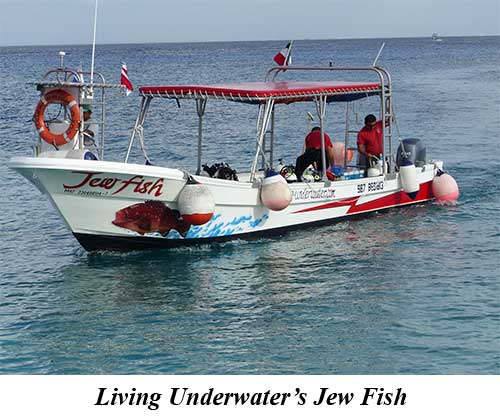 Jeremy began each day with the same
question, "Where do you want to dive
today?" Someone would toss out an answer
and after a little back and forth, off
we would go. However, the day before
divers depart, Jeremy lets them pick a
destination for a dive. When none of
the other guests had a request, I piped
up: "How about the Arches at Maracaibo
Deep?" Maracaibo is the southernmost
site on Cozumel, where the current usually
flows north at a good clip. Entry
to the curved swim-throughs is at 100 feet, so divers need to get down quickly to the fore reef at 90 feet if
they're to make it through the arches. Tough dive for the inexperienced, but
I love it.
Jeremy began each day with the same
question, "Where do you want to dive
today?" Someone would toss out an answer
and after a little back and forth, off
we would go. However, the day before
divers depart, Jeremy lets them pick a
destination for a dive. When none of
the other guests had a request, I piped
up: "How about the Arches at Maracaibo
Deep?" Maracaibo is the southernmost
site on Cozumel, where the current usually
flows north at a good clip. Entry
to the curved swim-throughs is at 100 feet, so divers need to get down quickly to the fore reef at 90 feet if
they're to make it through the arches. Tough dive for the inexperienced, but
I love it.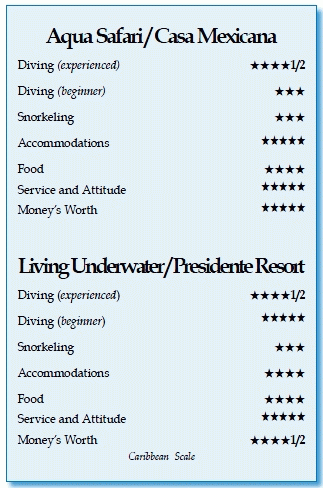 At Maracaibo, we arrived in
five-foot swells, with not another
dive boat in sight. Two fishing
boats trolled in the distance. I
asked Jeremy, "Do those guys monitor
marine radio?" They did. My buddy
and I each carried Nautilus radios
set to channel 6, the emergency
radio frequency. Chatter between the
boats is on channel 16, also used by
taxis, so it was comforting to know
that if we were adrift, we could at
least call a cab. We also carried
DAN surface safety kits consisting
of surface marker buoy, glow stick
and surface signaling mirror, buddy
lines and spare mirrors. (You can
never anticipate an emergency, just
plan for one, so we carry this kit
wherever we dive.) While Cozumel has
plenty of dives for less-experienced
divers, this wasn't one of them.
Jeremy judges each diver's abilities
before he takes them to advanced
sites like Barracuda and Maracaibo. Of course, newbies eventually need to
learn to dive in the "sub-marine wind," as I like to call it, so Jeremy tries
to show them how. This day two other divers, Canadians, were aboard -- an
avid underwater hockey player and his less experienced buddy.
At Maracaibo, we arrived in
five-foot swells, with not another
dive boat in sight. Two fishing
boats trolled in the distance. I
asked Jeremy, "Do those guys monitor
marine radio?" They did. My buddy
and I each carried Nautilus radios
set to channel 6, the emergency
radio frequency. Chatter between the
boats is on channel 16, also used by
taxis, so it was comforting to know
that if we were adrift, we could at
least call a cab. We also carried
DAN surface safety kits consisting
of surface marker buoy, glow stick
and surface signaling mirror, buddy
lines and spare mirrors. (You can
never anticipate an emergency, just
plan for one, so we carry this kit
wherever we dive.) While Cozumel has
plenty of dives for less-experienced
divers, this wasn't one of them.
Jeremy judges each diver's abilities
before he takes them to advanced
sites like Barracuda and Maracaibo. Of course, newbies eventually need to
learn to dive in the "sub-marine wind," as I like to call it, so Jeremy tries
to show them how. This day two other divers, Canadians, were aboard -- an
avid underwater hockey player and his less experienced buddy.